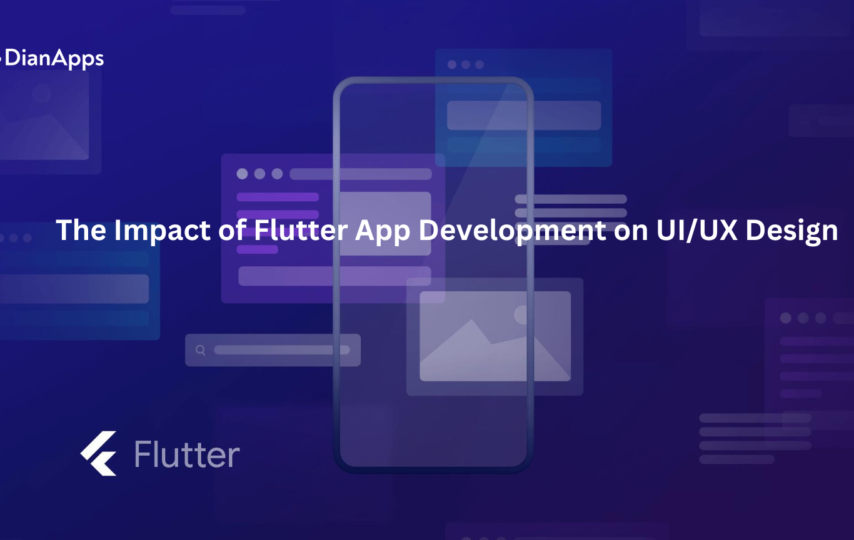The world of mobile app development has been transformed by Flutter, Google’s open-source UI toolkit. With Flutter, developers can create stunning, high-performance apps for multiple platforms with just one codebase. But the impact of Flutter doesn’t stop at development; it’s also revolutionizing UI/UX design.
Flutter’s rich SDK and flexible architecture allow designers to create beautiful, engaging user interfaces that are optimized for performance across a variety of devices. The framework’s customizable widgets, hot-reload feature, and support for animated UI elements make it easier than ever to bring design concepts to life. And with the ability to use Google Fonts and other design tools, Flutter offers designers the flexibility and creative freedom they need to create truly unique and impactful mobile experiences.
In this blog, we’ll explore the impact of Flutter app development on UI/UX design and highlight some of the ways in which this framework is changing the game for mobile app design.
What has made Flutter stand out from the crowd?
Flutter is a cutting-edge user interface toolkit developed by Google, which allows developers to create natively generated mobile, web, and desktop applications for various OS platforms. This innovative open-source framework utilizes the Dart programming language and offers a rich SDK that enables the development of stunning cross-platform mobile apps.
Major companies such as Alibaba and Tencent have already adopted Flutter for their app development initiatives, leading to a surge in popularity among mobile app development firms. Flutter’s success has caused several other frameworks like React Native, JQuery, Xamarin, and Angular to fall by the wayside.
With Flutter’s remarkable capabilities, developers can now build high-quality and aesthetically pleasing apps faster and more efficiently than ever before.
Why should businesses use Flutter in app development?
Flutter offers innumerable advantages to everyone and a few of them are illustrated below
For Designers
Flutter allows designers to create beautiful and immersive UI/UX designs that are easily customizable and can be integrated seamlessly with a variety of devices and platforms. The platform offers a wide range of design tools and widgets, which allows designers to easily experiment with different design concepts, and quickly create mockups and prototypes for testing.
For Users
Flutter-powered apps offer users an immersive and engaging experience with features like animations, smooth scrolling, and high-performance rendering. The platform is also known for its fast and responsive user interface, which can be customized to suit the user’s preferences.
For Developers
Flutter enables developers to build cross-platform apps that can run seamlessly on various operating systems, including iOS, Android, and the web. The platform’s hot-reload feature enables real-time code updates, which makes development faster and more efficient. Flutter also offers a rich set of pre-built widgets, which makes coding simpler and more intuitive.
Overall, businesses can benefit from using Flutter in app development by delivering high-quality, engaging, and responsive apps across multiple platforms. Flutter also enables businesses to reduce development costs, streamline the development process, and reach a wider audience with their apps. With these advantages, it’s no wonder that Flutter is quickly becoming a popular choice for businesses looking to build their mobile apps.
How can Flutter improve your UI/UX design?
1. Use of animation
Animation can help you if you want to offer your mobile app a distinctive and captivating touch. Of course, what we’re really talking about here is how to use animation to enhance the look and feel of your app, not to use HD or lengthy animation.
For this, Flutter provides a number of fundamental animation techniques to make use of the transitions from point X to point Y. For the purpose of basic animation transitions, Flutter provides the following features:
For Rotate: RotationTransition Class
For Translate: SlideTransition Class
For Route Transition: Hero Animation
For Scale: ScaleTransition Class
2. White space
The design of your mobile app can greatly influence how users perceive it, and transparency is a key factor to consider. White space is crucial for creating a clean and readable layout, improving the text’s legibility, and making it easier to navigate. Fortunately, Flutter mobile app development offers an easy solution to implement this design transition using the Padding widget. By following some basic guidelines, such as maintaining a minimum padding or margin of 8 points and a line height between 120 and 145 percent of the font size, you can ensure that your app’s text is well-aligned with other components and easy to read for users.
With Flutter, you can also adjust font size and style to enhance readability and create a seamless user experience. By prioritizing transparency and whitespace in your app design, you can improve the overall aesthetics and usability of your app, making it more appealing and engaging for your target audience.
3. Typography
Typography is the art of arranging type to create visually appealing and readable text. In app development, typography plays a crucial role in determining how users perceive and understand the content. Flutter recognizes the importance of typography and offers a helpful package called Google Fonts that provides access to a vast array of font types. This package enables developers to choose the right typeface for their app’s content while ensuring it is easily accessible and readable. By using Google Fonts, UX designers can apply the best typography strategies to create effective and stylish designs.
Ultimately, the typeface you choose can greatly impact how your app is perceived, so it’s crucial to consider how you present your content and how users will interact with it. With Flutter’s Google Fonts package, developers can create visually appealing and easily readable text to enhance the user experience and ensure that their app stands out from the rest.
4. Use of color
Choosing a colour scheme is a crucial part of UX design. Since colour has a psychological impact on users’ brains as well, the colour you choose will have an impact on how your app feels. You may create your app’s design and select the ideal colour scheme with Flutter.
5. Reload
Developers may view the changes they made to the code right away thanks to this special feature of Flutter. This allows both design pros to access any updates in a matter of seconds.
When the framework is being updated, developers can keep working on other features without having to wait for updates.
It lowers the time spent on UX design and app development while increasing the developer’s coding efficiency, saving you money on your overall mobile app development costs.
6. Icons
Making the best use of icons, photos, and graphics may significantly change how your app looks and help you make it more appealing. Make sure the icons you choose are straightforward and simple to recognize when picking your icon set. A few icon packages and the Flutter toolkit’s icons class are both available to you if you’re looking for new icons.
7. Glitch-Free User Experience
Developers may easily compare Flutter code to native code without interpreting it or running it on virtual machine like javascript UI frameworks even though Flutter is built on the top of Skia, a 2D graphics engine with hardware acceleration. On that account, Flutter-created mobile apps have excellent UX and are glitch-free.
Final Statement
In a nutshell, Flutter app development is transforming the UI/UX design landscape, providing developers with the ability to create visually stunning and highly interactive mobile applications for multiple platforms. Its open-source framework and rich SDK allow for a streamlined development, saving time and resources.
With Flutter’s innovative features like hot reload and widgets, designers and developers can create custom animations, dynamic layouts, and pixel-perfect designs. It has become a preferred choice among major companies and startups alike, and its popularity continues to grow in the app development industry.
If you’re looking to create a visually appealing and user-friendly mobile application that stands out from the crowd, consider working with a reputable Flutter app development company. Their expertise and experience in utilizing Flutter’s capabilities can help bring your ideas to life and create an app that meets your business needs and exceeds user expectations. Contact a reputable Flutter app development company today to get started.







